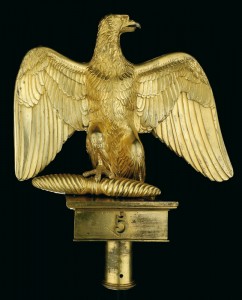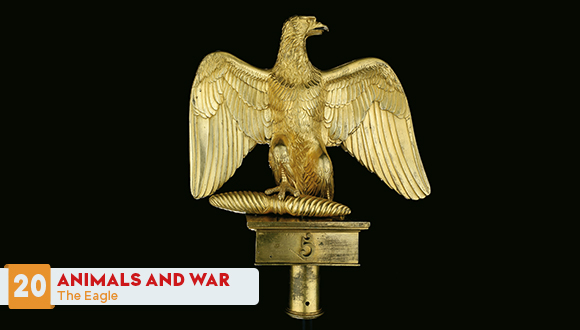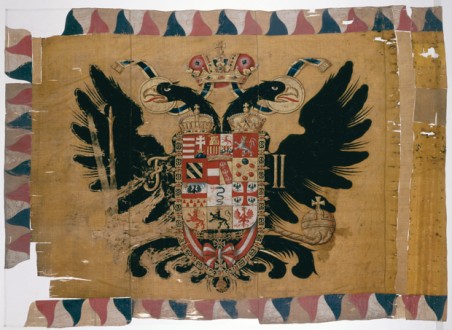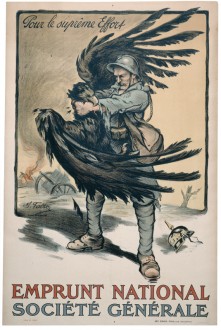
Flagpole « Eagle » number 5, 1804 model, designed by French sculptor Antoine-Denis Chaudet and cast by Pierre-Philippe Thomire © Paris, musée de l’Armée, Dist. RMN-GP / Pascal Segrette
Symbol of imperial power, the eagle was chosen by Napoleon I to adorn the standards of the Grande Armée. Looking to the left, the eagle is drawn up, the wings spread, one claw resting on “Jupiter’s spindle”. At the base is the regimental number ‘5’. Several models were realized. The first model made in 1804, was designed by French sculptor Antoine-Denis Chaudet and cast by Pierre-Philippe Thomire. On 5 December 1804, the soldiers of the Great Army swore allegiance to the eagle standards in front of the French emperor during an impressive ceremony at the Champs de Mars.
Austrian flag captured by the Napoleonic army in 1805. Reverse. Capturing the flag from the enemy constitutes a powerful act, a means of cutting off all communications among the different units and, more importantly, the symbolic affirmation of victory. This flag, representing a two-headed eagle, symbol of the Holy Roman Empire, is one of the trophies exhibited in the Saint-Louis-des-Invalides Cathedral. The double-headed eagle was used in the late Byzantine Empire. Later on it became a symbol of the Holy Roman Empire and was also used in the Imperial Coat of arms of Austrian Empire © Paris, musée de l’Armée, Dist. RMN-GP / Pascal Segrette
“For the Greatest Effort”. 4th National Loan WWI poster realized in 1918, by French artist Marcel Falter, born in 1866. This poster shows a French soldier dressed in a “blue horizon” uniform wearing an “Adrian” helmet in the process of strangling a German black Imperial eagle. On the ground lies the famed German spike helmet no longer in service since 1916, but a strong symbol designed to represent the enemy. In the background, fires, destroyed guns and broken trees remind us of the destruction caused by war and above all “the barbaric nature of the enemy” © Paris, musée de l’Armée Dist. RMN-GP / Pascal Segrette
The Eagle
A Formidable Symbol
Like the lion, the eagle is one the national emblems most used in the world. The German tribes regarded the eagle as the bird of the Norse One-Eyed Father God of War and Peace Odin. In 800 A.D., Charlemagne adopted the single headed eagle as the symbol of imperial power widely spread in Ancient Rome. From the earliest antiquity, the eagle was heavily associated with military glories and regarded as a divine bird owing to its association with the god of the sky Zeus/Jupiter. In French, the noun “eagle” assumes the feminine gender in heraldry and also when speaking of the “Roman Eagles”, on account of the feminine gender of aquila the Latin noun for eagle. Thus, in French, “aigle” is feminine, in Roman or Imperial eagle.
Napoleon I’s emblem
In accordance with Napoleon’s own choice, the eagle associated with power and majesty in reference to the Roman and Carolingian eagles and the bee became the emblem of the French First Empire. The decree of 21 Messidor, An XII (10 July 1804), stipulates that the Empire great seal and coat of arms of should be “azure with a gold, ancient eagle clutching a thunderbolt of the same colour”. The symbols were created by Dominique Vivant Denon (1747-1825) and Martin-Guillaume Biennais (1764-1843).
Absolute Power
The heraldic eagle also appears on the coat of arms of the Holy Roman Empire, the Russian Empire and the Kingdom of Prussia. Otto von Bismarck, the architect of German unification, introduced the single-headed eagle; a symbol still maintained in the coat of arms of the Federal Republic of Germany. During the First World War, this eagle became the symbol of the enemy, as opposed to the Gallic rooster. Accordingly, the eagle had come to symbolize not only the Germans but also the incarnation of evil. It was a symbol that was seen over and over again on French war propaganda posters and mentioned in patriotic songs such as R. Mercier’s 1916 song: Verdun! They shall not pass :
A dark eagle swooped over the city,
Swearing it would be victorious.
From all sides, crows are edging their way
In the furrows and the sunken paths.
All at once the cockerel of France begins to sound,
Cockadoodle doo! Up, little soldiers,
The sun is up, the guns are roaring.
Young heroes, here is the great Battle




Ajouter un commentaire